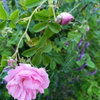David Austin sells START, with mycorrhizal fungi and bacteria, to promote phosphorus uptake and blooming.
Epsoma sells Bio-tone Starter Plus NPK 4-3-3 with mycorrhizae: 1,341 colony forming units (CFUâÂÂs) per gram of 7 different species.
Ectomycorrhizal Fungi: 97,440 propagules per gram:
Endomycorrhizal Fungi: 2.64 propagules per gram:
I researched on Epsoma - many people recommended that one. Krista in New York with 100+ blooms per spring flush per rose uses Mycorrhizae.
There's a study that documented increased soil uptake of these elements: Phosphorus, potassium, Magnesium, Zinc, Copper, Manganese, and Iron ... when Mycorrhiza is added.
"Effect of Inoculation with Mycorrhiza and of Added
Phosphorus on the Content of Different Elements in the Shoots of Corn"
No phosphorus added: P at 750 compared to P of 1,340 with Mycorrhiza fungi.
25 mg of phosphorus added: P at 2,970 compared to P of 5,910 with Mycorrhiza fungi.
So the effect of adding 25 mg of phosphorus, plus Mycorrhiza jumps the phosphorus from 750 to 5,910.
The jump of iron is impressive, from 80 (no phosphorus added, no fungi added) to 277 with 25mg of phosphorus and mycorrhiza.
Here's a quote from Plant Nutients site: "Phosphorus (P), however, is directly affected by pH. At alkaline pH values, greater than pH 7.5 for example, phosphate ions tend to react quickly with calcium (Ca) and magnesium (Mg) to form less soluble compounds. At acidic pH values, phosphate ions react with aluminum (Al) and iron (Fe) to again form less soluble compounds. Most of the other nutrients (micronutrients especially) tend to be less available when soil pH is above 7.5.
See the link below for increased uptake of many elements with mycorrhiza added. Scroll down to see the table.
Here is a link that might be useful: Increase soil elements with mycorrhiza innoculation








User
roseseek
strawchicago z5Original Author
User
strawchicago z5Original Author
taoseeker
strawchicago z5Original Author
User
strawchicago z5Original Author
strawchicago z5Original Author
jeannie2009
strawchicago z5Original Author
Kippy
nastarana
User
strawchicago z5Original Author
strawchicago z5Original Author
henry_kuska
kittymoonbeam